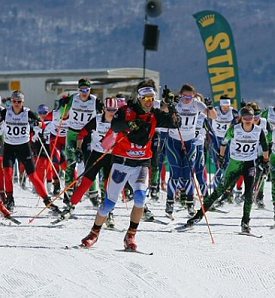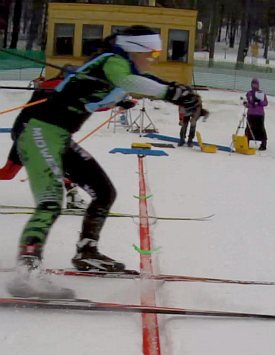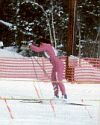Junior Nationals Coverage
March 11, 2014A recap of our 2014 Junior Nationals coverage...
Junior Nationals Preview
February 26, 2014Hard to believe, but Junior Nationals competition starts up next Monday at the Trappe Family Lodge in Stowe, VT. We've got a breakdown on the events and a look at the 2014 Midwest Junior National squad. Check back for on-site coverage all next week!
Junior Nationals Trip Photos
A large photoset from the trip covering topics like the flights, practices, date-ski, hair dye, award ceremonies, athlete parade, and more.
Course Preview: 5K
A preview of the 5K course used for both the classic and freestyle distance races.
Junior Nationals: Classical Coverage
March 3, 2014Junior Nationals in Stowe, VT, began the competition with individual start classical races Monday. The Midwest had a banner day, posting some of the best results in years as a team. Leading the way, Zak Ketterson and Ian Torchia took 2nd and 3rd respectively in the boys J1 race and Vivian Hett was second in the J1 girls by less than 3 seconds! The J1 girls posted 6 in the top 14 and the J2 girls had 5 in the top 12. Other top results: Matt Nichols 7th OJ, Sam Elfstrom 8th OJ, Jan Ketterson 11th OJ, Tom Bye 13th OJ; Nick Gardner 10th J1, Leo Hipp 11th J1; Nora Gilbertson 8th OJ girls, Kris Bourne 10th OJ girls; Rocci Wohlk 6th J1, Mattie Watts 7th J1, Anna French 11th J1, Alayna Sonnesyn 12th J1, Allison Ternes 14th J1; Amanda Kautzer 5th J2, Hannah Rudd 6th J2, Claire Benton 9th J2, Anna Johnson 11th J2, Erin Moening 12th J2. Results linked in, full photosets posted.
Course Preview: 1.5K (sprint course)
A preview of the classical sprint course.
Junior Nationals: Classical Sprint Coverage
March 5, 2014It was an outstanding morning for Midwest athletes at Junior Nationals in Stowe as classic sprint qualifying heats wrapped up. The top 30 athletes from each age division advanced to afternoon quarterfinals and included a large contingent of Midwest team athletes (over 30 skiers). Noteworthy morning results: Zak Ketterson: 5th fastest MU18 qualifier, Luke Brown: 9th best MU20 time, Amanda Kautzer: 5th fastest FU16 qualifier, and Mattie Watts: top FU18 qualifying time of the morning. Skiing through quarterfinals and semis brought a select group to the top of the heap, including Amanda Kautzer 1st overall for FU16 girls, Zak Ketterson 5th overall MU18, and Kris Bourne 5th overall FU20. Mattie Watts and Vivian Hett went 2-3 in the FU18 final with Sarah Bezdicek bringing home another 5th place for the Midwest Team. Results linked in, along with big photosets of the Midwest skiers and video recaps of all the A finals.
Junior Nationals: Freestyle Coverage
March 7, 2014Friday's mass start freestyle races in Stowe for the 2014 Junior Nationals showed some great Midwest team results. Tom Bye skied up from 11th position to snag the 3rd U20 finish and the 2nd American in the 15k. Matt Nichols and Jan Ketterson finished 5th and 7th. Kris Bourne finished 4th in the girls U20 10k with teammates Nora Gilbertson, Sonja Hedblom and Maria Hauer claiming 7th, 8th and 9th. Ian Torchia represented the Midwest on the podium with 3rd in the boys U18 10k skate. Zak Ketterson claimed 7th. Midwest U18 women were dominant in the 10k skate, with Vivian Hett claiming 3rd place, and teammates Caroline Brisbois finishing 5th, Rocci Wohlk 6th, Alayna Sonnesyn 7th, and Mattie Watts 9th. Wrapping up the U16 classes, Anders Sonnesyn had the best Midwest boys 5k time in 15th place while Erin Moening finished 9th for the girls. Results linked in, along with big photosets from all the races.
Junior Nationals: Relays Coverage
March 8, 2014Junior Nationals in Stowe, VT, wrapped up on Saturday with the 3X3K freestyle relay events. The Midwest team finished the week strong, especially in the U18 division where the girls collected 2nd and 3rd and the boys 3rd and 6th. The U20 gals also snagged a podium spot with Kris Bourne anchoring the victory by a boot throw. Tom Bye nearly pulled his U20 team onto the podium as well, finishing 4th by less than a second. Other top results: U16 girls nail down 5th, boys 9th and Nicole Schneider racing up with the U20s helped secure an excellent 5th showing. Results linked in, video recaps of most of the races, and a few post-race photos added.
Various Final Notes
Leadout
 The Junior National races used the same opening segment for all the events. This featured a flat start area, which quickly turned to the left and drived into a downhill banked 180 turn. While this was very negotiable for individual starts and sprint heats, it proved to be a problem area for the mass start events, as the opening U20 race field had some pretty serious crashes. Organizers scrambled and quickly implemented a cycling-like lead out, where a skier (Jeremy Hecker from the Midwest) would led the start field in a paced, non-racing ski through the opening curve and part way up the first climb then would drop out to allow racing to begin. Even with the lead out, there was another crash during the U16 boys field start.
The Junior National races used the same opening segment for all the events. This featured a flat start area, which quickly turned to the left and drived into a downhill banked 180 turn. While this was very negotiable for individual starts and sprint heats, it proved to be a problem area for the mass start events, as the opening U20 race field had some pretty serious crashes. Organizers scrambled and quickly implemented a cycling-like lead out, where a skier (Jeremy Hecker from the Midwest) would led the start field in a paced, non-racing ski through the opening curve and part way up the first climb then would drop out to allow racing to begin. Even with the lead out, there was another crash during the U16 boys field start.
For the relays, a couple of changes were made to reduce this problem. First, they broke the relay fields into six events, instead of the traditional four (usually U18/U20 fields are combined). Second, they extended the start area, and that, combined with the smaller field sizes, allowed for a safer passage through the opening downhill curve.
Sprints
This year at Junior Nationals they switched to a new "lucky loser" format for selecting sprint heat advancement. In the past, the lucky losers were advanced based on their qualifying placement. This year they changed to the more common practice of using the fastest heat times for selection.
Timing
A couple of interesting timing notes, gathered from John Burke (of Performance Timing in Wisconsin), who assisted the lead crew of Summit Timing (Ernie Page).
- Cameras: A FinishLynx camera was used to determine the winner in tight mass start finishes (this is the camera that has the striped freeze images seen on the results page of Summit Timing). They also experimented with some security cameras to collect finish images from multiple angles, which Burke suggested might be a good alternative for smaller scale events.
- Day-in-the-Life: Burke explains a "normal" timing day workload...
"Typically, I arrived about 2-3 hours before the first start and stayed until we had everything tore down for the day. The problem with ski races is that you basically have to take everything down each night which is almost like starting from scratch each day. Ernie normally did all computer work getting the finish results official and posted. There are downstream things that have to be done with the results as well with the calculation of Alaska Cup points, Club points and Team points. We ended up splitting some of that up. Then it was time to turn attention to the next race which meant new start lists and timing configuration. Since each race was a different format, it required a different set-up and deployment of timers and other equipment. It also required getting final instructions from the race jury about certain details that impacted establishing the start lists which is why they sometimes don't get posted until later in the evening. In the case of the relays, it meant a lot of manual entry of the teams after Friday's races since coaches mostly determined their relay configurations on the Friday results. The night before a race, we were usually at the competition building until after 10:00 or 11:00 at night just making sure of everything." - Lap Times: If you examine the lap splits, you may notice the first lap times appear to be faster across the board. Burke explains how lap timing is performed: "The timing point was located basically in line with the finish line in the lap lane. That means, skier 1's time was finished before she skied around the corner and went down to tag off. Then skier 2 had time from the when skier 1 went across the lap line to when they crossed the lap line. Skier 3 would have a similar "timed" distance as skier 2 which was basically one complete lap. Skier 1 had the shortest timed distance."
Poles, Falls and Boot Throws
 The mass start races (freestyle distance and relays) generated a fair amount of broken poles. In general, the Midwest skiers received replacement poles quite quickly, though they once in a while needed to swap to get the "right" pole.
The mass start races (freestyle distance and relays) generated a fair amount of broken poles. In general, the Midwest skiers received replacement poles quite quickly, though they once in a while needed to swap to get the "right" pole.
Kris Bourne had quite the excitement in her two mass start races. In the freestyle distance race, she fell multiple times in the first lap, but was able to rejoin the lead group and eventually finished 5th. In the relay race, the U20 gals featured Nora Gilbertson moving the team up from 10th to 5th, and then Bourne taking it from 5th to finish 3rd in a boot throw that had to be reviewed by camera to before the placing was finally posted. (Photos of the finish security cameras are posted in the relay coverage.)
Team Traditions
The Midwest team has a number of traditional events during Junior Nationals. One of them, started roughly 5-6 years ago, is the date-ski. The date-ski involves one of the senior team members pairing up boys and girls for a "date" on skis during a morning practice session. The pairings frequently involve older skiers with younger ones, and this year even a few trios (because of the smaller number of boys). The pairings are suppose to ski at least one lap together, and attempt to learn more about each other. Many of the skiers, especially the veterans, dress up for the event. It's been one of the highlights of the trip, and a great way to meet new teammates.
Another tradition for the Midwest skiers is hair dying. For the girls, it usually involves red or pink hair dye (including bleaching for dark hair). Usually the older girls help lead the effort, and over the years have developed preferences for specific brands of hair dye and materials. Some guys also get involved, although the outcome can be a bit unpredictable (some guys got a little more bleaching than expected!).
Photos from both the date-ski and hair dying process are in the Junior Nationals Trip photo album.
One of the final day traditions is the team awards. The night before, the team votes on candidates for the awards, and then they are announced, usually after the final race and when everyone has packed up. This year's award winners were - Team Captains: Kris Bourne and Tom Bye; MVP: Vivian Hett and Zak Ketterson; Rookie of the Year: Claire Benton and Nick Gardner; Spirit of the Midwest: Mattie Watts and Luke Brown.
Midwest Girl Power
Just how good was this crop of U18 girls from Minnesota? It is interesting to compare their placing at Junior Nationals versus their State Meet finish. Vivian Hett posted 2nd in classical and 3rd in skate at Junior Nationals versus 2nd in both at the State Meet. Rocci Wohlk finished 6th in both events at Junior Nationals versus 9th in the State Meet skate and 4th in the classical. Caroline Brisbois was 5th in the Junior Nationals skate and 3rd skate at the Minnesota State Meet. Looking at the field overall for Junior Nationals, the Midwest U18 gals scored eight top 20 finishes in both the classical and freestyle distance races, plus took second and third places in both the sprint and relay races. And to emphasize their domination, they won their U18 division in the Alaska Cup points by 41 points.
LNR and Wayzata
The Loppet Nordic Racing club showcased their own dominance, sweeping the girls and boys club titles, and obviously the overall club crown. The Wayzata high school quad of Alayna Sonnesyn, Anna French, Nicole Schneider and Micheala Keller-Miller won the girls high school title (many of these gals also collected the high school cross-country running national title - quite a season!).
On to 2015
The 2015 Junior Nationals will be hosted by the Auburn Ski Club, based out of Soda Springs, California, March 8-14. They have a preliminary website up and have begun their Facebook campaign.
Thanks
Finally, we want to say a huge thanks to all that helped make the trip possible for us. The Midwest Junior National Commitee, Maplelag Resort, and many parents and coaches provided donations and resources to help get us there and cover the costs. Without their generous support, we simply would not have been able to make the trip -- Thank You!

